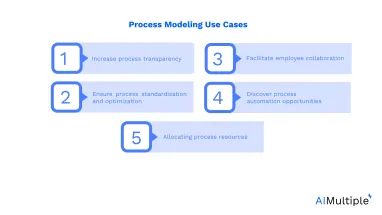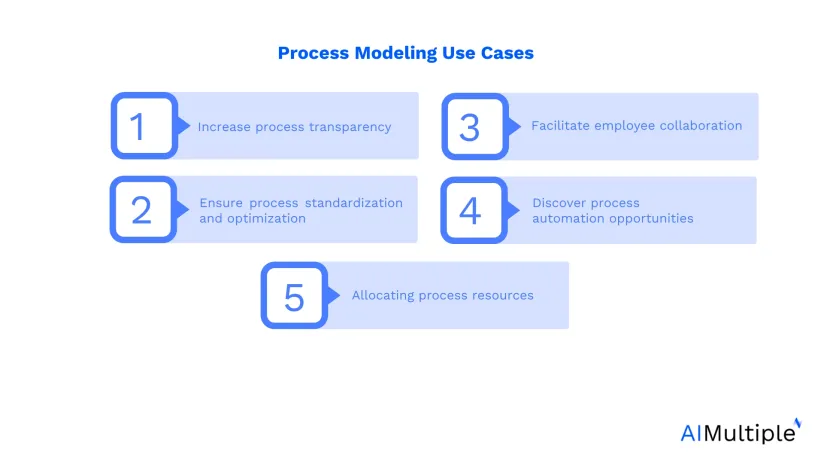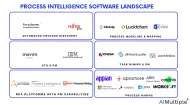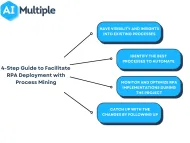Process Modeling in '24: Top 5 Use Cases & Case Studies


Process management allows companies to improve their processes so that they can enhance their process efficiency and customer satisfaction while decreasing cost. Yet, business analysts often do not know every activity and steps involved in processes despite interviewing with employees who directly involved in the processes. Business process modeling which is a data-driven method used under business process management can help overcome this challenge. Process modeling enables analysts to discover, visualize, analyze, and improve business processes while estimating the success of a modification to a business strategy.
This article explains process modeling and its top five business use cases.
What is business process modeling?
Process modeling is the practice of visualizing business processes and workflows. By including every individual step, process models provide an end-to-end overview of the tasks and activities in business processes. Process modeling reveals insights about:
- Events and activities in a workflow
- The people involved in these activities and events
- Decision points together with the paths and outcomes
- Systems and devices used in the process
- Timeline
- Success and failure rates
The graphical representation of the processes facilitates business leaders and analysts to inspect and improve process efficiency accordingly.
The advantages process modeling offers to include:
1. Increase process transparency
Process modeling helps understand how processes function with all steps and identify the factors that bring loops, repetitive works or errors, and the elements that bring efficiency and success.
Example
HSA Bank1 benefited from process modeling to understand and analyze their processes. The bank detected several tasks to simplify and clarify during the modelling, which improved their case resolution by 75%.
2. Ensure process standardization and optimization
Process modeling helps organizations understand internal procedures, rules and standards to align other processes that do not follow the required structure. Business leaders can optimize and standardize these processes based on their insights.
Example
Cofco International1, one of China’s largest food and agriculture companies, applied process modeling to visualize and understand their compliance with the country-based laws and grain standards across different countries. The company traced and updated its processes with process modelling to ensure compliance and optimization.
3. Facilitate employee collaboration
Since process modeling allows businesses to visualize and understand actual processes, business leaders develop more accurate business strategies and communicate with employees based on the process graphs. As a result, process modeling streamlines the coordination of systems, people and information in the organization.
Example
Westpac New Zealand Ltd. leveraged a process management solution to model and document their processes. The bank had a task document repository, into which staff members had to email the documents for storage. Therefore, they stored the documented processes in three months and created more than 2000 reusable artefacts. Over 130 employees use these documents and collaborate through them in new projects.
4. Discover process automation opportunities
Process modeling facilitates process automation as it enables business leaders and analysts to view and discover points and tasks that can benefit from automation.
Example
The multinational printer and copier manufacturer Kyocera1 captured their pricing approval processes with process modeling. By better understanding their processes, they detected several processes that can benefit from automation. That reduced the approval time by 85%. As employees allocate only 20 minutes per approval, they focus on other tasks, which improves overall efficiency.
5. Allocating process resources
Process modeling indicates the involvement of people in certain tasks or the usage of tools, devices and systems within a workflow. Therefore, businesses can leverage the modeling to determine if their resource and monetary investments generate expected returns.
Example
One example would be that the manufacturers can understand their machinery usage in their production processes. Process modeling can show which machinery is utilized less and is utilized more frequently. Based on the insight, manufacturers can decide to re-allocate the work across the tools or disinvest in the machinery that is not helpful for their business to save money.
Further reading
If you are interested in process improvement and process discovery, you can check out our relevant articles:
- Process Improvement in 2022: In-depth guide for businesses
- Process Discovery in 2021: What it is & How it works
If you want to use business modeling tools for your business processes, feel free to check out our data-driven list.
Model your business processes with latest management tools and technologies, including:
- Workflow management software
- Business process management software
- Low-code/No-code development platform
- Onboarding software
And if you need guidance to find the right vendor, let us talk to you:
Sources
1 case studies



Comments
Your email address will not be published. All fields are required.